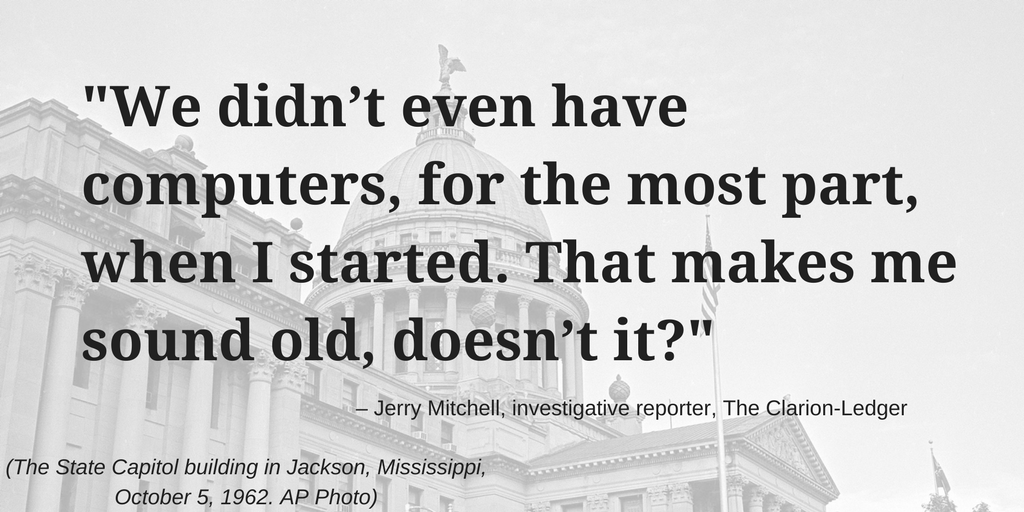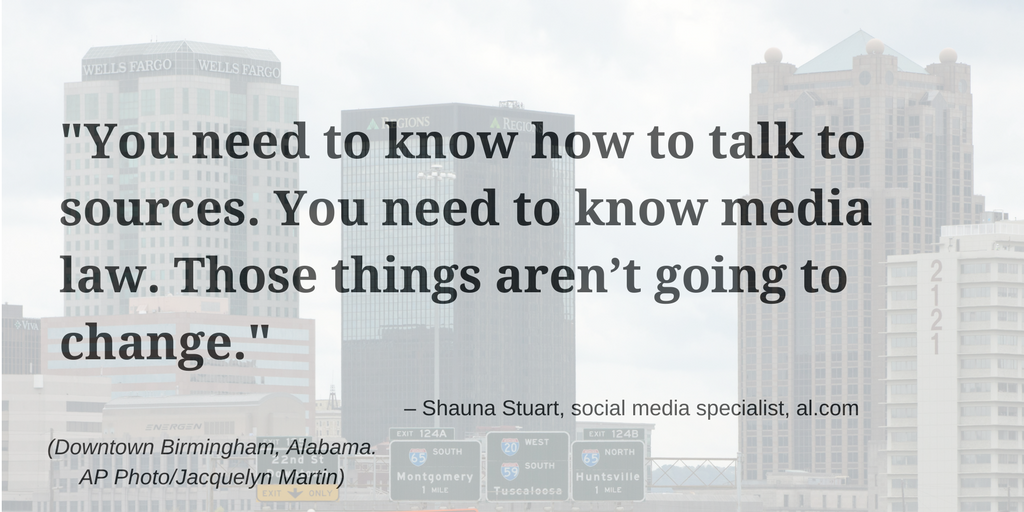This article originally appeared in our weekly newsletter, Local Edition. Are you part of the conversation? Join in here!
This week, I talked with two Southern journalists. One’s a seasoned pro. The other’s in the early stages of her career. Before long, one had advice for the other.
“Honestly, and this sucks but I’m gonna say it, you just have to play with (social media),” Al.com’s Shauna Stuart told Jerry Mitchell of the (Jackson, Mississippi) Clarion-Ledger. “Sit with someone who you feel comfortable with in your newsroom and get a tutorial.”
Stuart, a social media specialist, and Mitchell, a much-lauded investigative reporter, were a great pair to start our next month-long discussion.
Here’s the big question: What skills do you have to build to stay in journalism? Next week, I’ll round up your answers, so please email or tweet them at me.
OK, let’s get started.

Jerry, meet Shauna, Shauna, meet Jerry. Please introduce yourselves to each other and tell us about your career. Do you want to start, Shauna?
Shauna: Sure! I’m a social media specialist at Al.com. A lot of my work is focused on running social on special projects, including more longform journalism and more features, and really building audience around that.
Our director of social media noticed that people were saying, “why don’t you cover this in Alabama, why don’t you cover that?” People just missed all of that content. So she wants to build a team that’s devoted to really putting a spotlight on all that.
Jerry: I’m an investigative reporter with the Clarion-Ledger. I like chasing bad guys. I’ve been doing that for awhile. I started as a regular reporter in Arkansas and Texas and finally Mississippi. I was a bureau reporter and then started covering courts and stumbled across some sealed documents and that led me onto my journey into looking into cold cases from the Civil Rights movement.
I just did a serial killer case, that was my first one. That’s what I’ve been doing.
I’m woefully ignorant about social. I do have a Facebook page and Twitter and all that, but I still feel totally inept.
Well this is a good conversation for you, then. How has journalism changed since you first started, and in what ways have you adapted?
Jerry: I mean, it’s changed almost completely in a lot of ways. We didn’t even have computers, for the most part, when I started. That makes me sound old, doesn’t it? I started out on an IBM Selectric. It’s changed a lot.
I would like to be better in everything.
For this latest project, I wrote not just a 30,000-word final story, but we had a documentary and engaged people socially as well. That was a really good experience and taught me a lot about how important it is to be up-to-speed on all the new methods. You have to begin to learn them.
I think one of the more frustrating things about it is you never know if it’s gonna stick. We’ll have training on something, and six months later, we’re not using it. It’s kind of frustrating because you have no idea — is this gonna last, is this not gonna last, are we gonna change to something different a year from now?
Before all this, you kind of had a way you did things for a very long period of time. We started with QuarkXPress…
I remember QuarkXPress!
Jerry: I loved QuarkXPress. I just think computers have changed everything, and now social media has changed everything, and what I find interesting is, a lot of the time, as an investigative reporter, the way you do a story hasn’t changed at all.
It still involves getting out there and talking to people.
What about you, Shauna? What’s changed since you first started, and how have you adapted with it?
Shauna: I don’t know if this was a change or just something I was late to noticing, but I feel like there’s way more of a need for really solid design skills. I went in as a web producer at Georgia Public Broadcasting/ GPB News, and then moved up to the audience team at “Frontline.” So for me, being able to have a really good grasp of graphic design and being able to think conceptually and design thinking are really important. Do I have all of it that I wish I had? No.
It’s so interesting that you say that, because our first boss two weeks ago was Tony Elkins from the Sarasota Herald-Tribune. He started as a designer. He said he sees more people rising through design ranks in newsrooms because they have those design-thinking skills, they’re nimble, they’re the people who talk to everyone in the newsroom. I never really thought about it that way before, but now that he brought it up, those skills do make a lot of sense as essential for everybody right now.
Shauna: I agree. I wasn’t originally thinking that way because I wanted to go into local TV news. But now when I’m thinking of a project, I need to design something to catch people’s eye on social and it’s like, ahh I’m struggling. Teaching yourself is always hard when you’re working.
One of you is early in your career, the other is well-established, and I’m guessing that the skills that you both need will be different. Shauna, what skills do you need to stay in journalism? Is it design? Is it more design?
Shauna: The skills that Jerry has as an investigative reporter, we all need those skills. He has the foundation, he has the experience. That’s never going to change. I think having design skills and data skills don’t make up for the fact that you need to have a very solid basis in reporting, even if you don’t want to be an investigative reporter. You need to know how to talk to sources. You need to know media law. Those things aren’t going to change.
I think for what I’m doing, I need to be able to know more design skills, data journalism as well. Even if I can’t clean an entire sheet of data and do a data report, being able to scrape a page takes skills. I need to be able to know VR, know how to work Facebook Live, so when something happens out in the Gulf and I’m on shift for social, I need to be able to say, here’s what you need to do. That’s essential for me.
What about you, Jerry?
Jerry: I think I need to get better with social. I’m also interested in video. I wouldn’t mind taking the next step and really become a full-fledged documentary filmmaker. I think I’ve got a decent idea for one right now.
One of my hobbies is writing screenplays, so I do that, too. I’m always interested in story. I think that’s not gonna change, telling a good story. I think what changes is how you tell it. What platform do you use to tell that story? Ideally you use multiple platforms to tell a story. When you do a good job of that, people are engaged.
How do you both find ways to keep learning and growing? We’re all, myself included, in newsrooms that are a lot smaller than they once were and everyone’s doing a lot more than they once did.
Jerry: I’ve done some stuff with Poynter, and we do some training internally. I’d like to do more like my son does. If my son wants to learn something, he just gets on YouTube. It kind of cracks me up.
It’s tough because I’ve got a screenplay that I’m very close to selling, I’ve got a book I’m in the middle of. My life is pretty packed in addition to my day job.
One of the things I thought was interesting when we talked about “Gone” was working with filmmakers, people from the video department. Have your coworkers helped you keep evolving?
Jerry: I think so. We have a number of young journalists. For them, it’s almost intuitive the way they use social media. For me, it’s not. I’m not always taking pictures of my dinner and posting it on Facebook or Instagram. I’ve just got to get better and figure out how to be more nimble at it. Hopefully Shauna has a lot of good advice.
Shauna: Honestly, and this sucks but I’m gonna say it, you just have to play with it. Sit with someone who you feel comfortable with in your newsroom and get a tutorial.
Learning it by yourself is actually kind of boring. That’s why it’s called social.
Jerry: I’m comfortable with Facebook, I’m comfortable with Twitter, but Instagram, I’ve barely been on it. And there are other ones popping up all the time. I guess I just wonder, should I be doing something on Instagram?
Shauna: Well, for example, your films – being able to think visually on Instagram is really helpful. Follow film accounts. They’re really innovative in the way they do things. If you want to learn about social, don’t look at news. I’m not saying we’re not doing innovative things. But you can draw from that.
That’s really good advice. How have you found ways to keep learning, Shauna? It sounds like you have a learning side hustle going on right now.
Shauna: A learning side hustle! I wish I was as adept as you make me seem. First, I was part of the inaugural class of Poynter’s NABJ Leadership Academy. So I would say, No. 1, apply for things. Even if you don’t get it, as you fill out an application you can say, I wish I knew this.
Also, I’m lucky enough that I’m in a local newsroom that’s very creative. They’re always sharing resources. The biggest part in learning, I think, is time management. There’s so many free things out there. Try the free stuff. If you get to the point where you’re lagging, then you can start paying for it.
Are there things newsrooms could do to help journalists have time to learn those new skills?
Shauna: That’s a really tough question, because if you’re off learning this, who’s going to cover your social accounts, or this shooting still happened, or this story? Sometimes, saying, “hey, learn this in addition to your job,” people will become resentful. I’m not sure how exactly to do that.
Maybe talk to people in your newsroom and say, we want to help you learn these skills. What would be helpful for you?
What else, other than journalism skills, do you think you both need to stay in local journalism?
Jerry: Some of them are more basic than what we think of as digital skills. I think we need to be better at getting out of the newsroom. I view that as a problem sometimes. We can get so locked into being in the newsroom, we’re so busy, everything’s on fire. We’re just constantly putting out fires. We need to be able to get out more.
Whenever writers come through town, we try to grab them and have them come talk to our newsroom and buy (them) pizza or something like that. It’s free lunch, they learn how to write, and that’s a skill that’s going to continue.
Even at this point in my career, I still have this deep desire to get better at writing.
Shauna: I’d love to have better writing skills.
Being able to talk to people in your community is super important. I’m a huge proponent of that. Especially in digital, we have this habit of thinking about our audiences with contempt. That’s a heavy word, but we get so used to saying, “that’s not gonna work on social, don’t do that.” We have to break from the mold. That’s a reason that we don’t go the extra mile sometimes, but it’s not an excuse. And we have to measure success not just in pageviews and clicks, but did we do something out of the ordinary?
Being new to your community, do you see yourself staying in journalism at the local level?
Shauna: Honestly, I don’t really look at market size. That’s not really impacting my decision on where I go next. It’s more what skills can I build and what projects can I work on?
And Jerry, you’ve chosen to stay at the local level for other reasons, right?
Jerry: Yeah. The stories. Mississippi’s a great place, news-wise. I’m fascinated with it and continue to be fascinated with it. I never intended to move to Mississippi, and once I moved to Mississippi I never intended to stay, and now I’m pretty sure I’ll never leave. It’s a fascinating place. We’re the best and worst of America.
I’m a dinosaur, I know that. But in a way, I think it’s better. Not that there wouldn’t be some excitement working for a national publication like The New York Times or otherwise. I don’t know, I really like where I am, and they let me experiment and do different things like I did with “Gone.” It’s not every day that a reporter comes to an editor and says, “We really should do a documentary on this,” and they go “OK, we’ll do it.” I was tickled.
In the last cycle of Local Edition, I asked journalists why they’re still journalists, and I got some amazing answers back. Why are you both still in journalism?
Jerry: Because we can make a difference in people’s lives, and sometimes making a difference is nothing more than just letting people tell their stories, and sometimes making a difference is changing the conversation, and sometimes making a difference is changing lives and changing society. Just to be a part of that is so incredible.
It’s not even about us anymore. I still believe that journalism is one of the most noble professions in the world. And I think that we are at our most noble when we are making a difference in people’s lives.
Shauna: My answer doesn’t sound as smart, but there’s so much creativity in this field. There’s so much creativity in journalism. We have this devotion to storytelling.
Even when you look at films like “Daughters of the Dust,” there’s always a real-life narrative that mirrors these films. There’s always something with a real-life foundation. As journalists, being able to tell that real-life story is very noble, I think.
A lot of people said, “with ‘Moonlight,’ I finally saw myself in a film.” Those are real people saying that. As journalists, we go back and we tell those stories.
At the bottom of every single amazing, flowery thing, there are real people, and we get to talk to them.
That’s an amazing job.
Amen.

Thanks to Shauna and Jerry for the great discussion!
Now, it’s your turn. What skills do you need to stay in journalism? More basics? Coding? Design? Video? Social? Ninja FOIA skills? Next week, I’ll share your answers, so please join the conversation.
Until next time, here are some opportunities worth checking out: The Midwest Center for Investigative Reporting is looking for a fellow. ONA Local events are coming up in New England and Las Vegas. And Poynter’s Room for Trust takes place next month in San Francisco.
See you all next week!
(But share what skills you need to learn first!)
(Please!)
(OK, bye for real!)







